53 F. average high for April 7.
64 F. high temperature on April 7, 2011.
.17" rain fell yesterday at Twin Cities International Airport.
8.9" snow fell on stunned residents of the Twin Cities back on April 7, 1923
Frost likely Tuesday and Wednesday in the suburbs; immediate downtowns may remain frost-free.
.5"+ rain possible late Thursday into Friday. We seem to be transitioning into a wetter pattern - finally.
22" snow Fishtail, Montana (Stillwater county)

Payback. You didn't really think there wouldn't be any payback for all those 70s and 80s, did you? After flirting with 60 today a colder front arrives Monday - a good chance of suburban frost Tuesday and Wednesday. There may be some minor frost-damage, but right now I don't see a widespread frost within the 494/694 freeway system.
"Weather consulting firm Planalytics said several major cities experienced their warmest March in 118 years, including Chicago, Detroit, Minneapolis and Oklahoma City, where temperatures were about 15 degrees higher than average." - from a Washington Post article below.
"Actually, one of America’s greatest conservation stories of recent years is that, as a country, we use less water today than we did in 1980. In that span, the United States has doubled the size of its economy and added 70 million people, yet we use 10 percent less water than we did 30 years ago." - from a Washington Post article below.
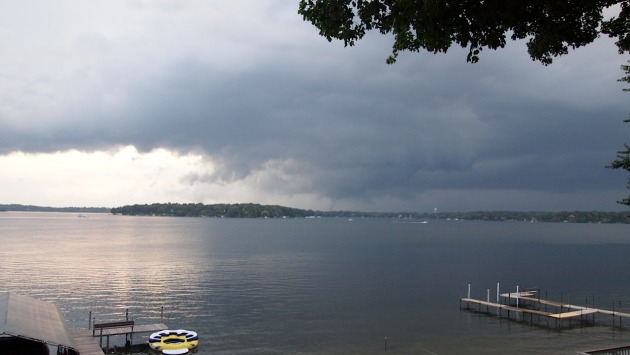
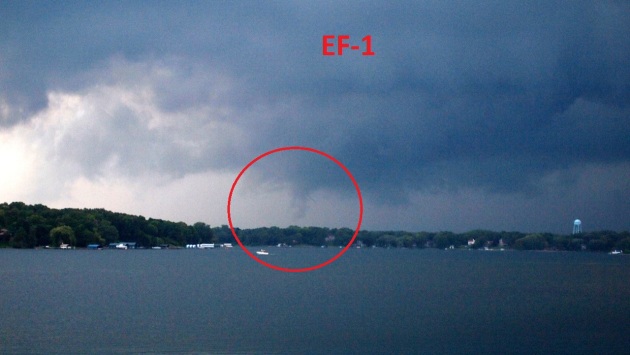
Tornado Sighting - From My Dock? I dug out this old photo taken on August 8, 2009, looking west, toward Mound and Navarre - showing a developing EF-1 tornado. The funny thing - the sky turned that (evil) shade of green, I ran down to the dock and began snapping photos of this developing tornado. Two minutes later the sirens began to sound. Bottom line - do NOT rely on the sirens. They are not activated by the National Weather Service - every local community sounds the sirens at their discretion, for everything from tornadoes to fires to...well...almost anything. It's a mess, and a potential liability for consumers who are very confused about what the siren means from one day to the next.


"Lunch With Paul". How 'bout an appetizer of Viper Doppler radar? I had the honor of sitting down with Jeffrey Morris "FutureDude" recently to talk about my tortured career and take a peek into the future. Details below.
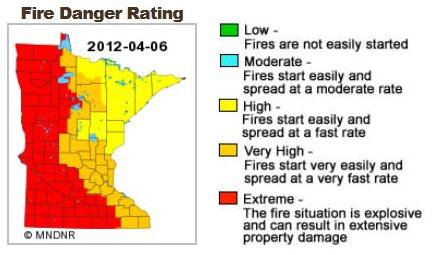
Growing Fire Danger. Here is the latest fire threat map, courtesy of the Minnesota DNR. There is now an extreme fire danger over roughly the western half of Minnesota, meaning "the fire situation is explosive and can result in extensive property damage."
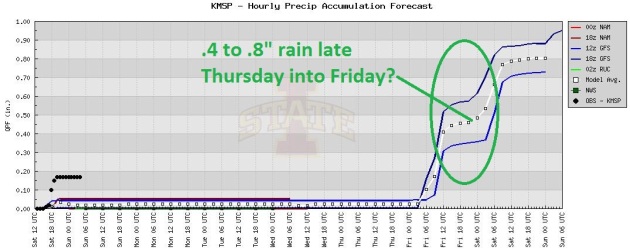
Outlook: Friday Puddles. A southern storm may spread steady rain into Minnesota late Thursday and Friday, and some half inch plus rainfall amounts are possible.

Last Frost Of Spring? I hope so - but I wouldn't bet the farm, or your back yard flowerbed on it. The GFS is pulling more Canadian air into town around April 17-18, possibly 1 or 2 more frosty nights the third week of April - followed by more 60s, even a couple of 70s between April 20-23. We'll see.
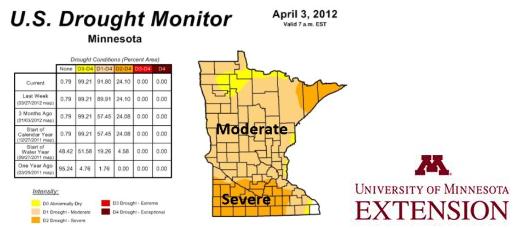
Soil Moisture Still Short, But Improving In Some Places. Here's a snippet from this week's WeatherTalk blog, courtesy of Dr. Mark Seeley: "University of Minnesota Research and Outreach Centers monitor soil moisture conditions for Minnesota's major crops. Last fall's (2011) measurements made it obvious that soil moisture storage was well below normal going into the winter season. For many areas over winter and early spring precipitation has been inadequate to help fully restore soil moisture to near normal levels for the spring. At Lamberton the final measurements from last fall showed 2.95 inches of stored soil moisture in the top 5 feet of the soil profile. Measurements made earlier this week showed that the profile moisture content had only "improved" to 3.09 inches of stored moisture, still roughly 2.5 inches less than average for this time of year. Further much of this moisture lies well below 3 feet and is out of the reach of crop rooting systems early in the growing season. So additional spring rains in April and early May are needed to recharge the upper layers of the soil for good germination and early development of corn and soybean crops."
* The latest U.S. Drought Monitor, zoomed in on Minnesota, is here - courtesy of NOAA.
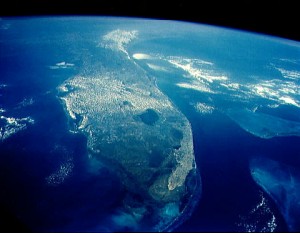




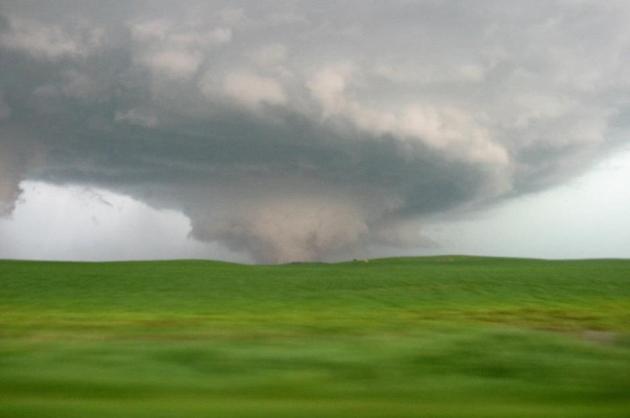
"Tornado Alert": rotation on Doppler radar - conditions ripe for a tornado to form. Stay alert and stay tuned to (multiple) different forms of media to monitor the situation. Be ready to move to a place of safety.
"Tornado Emergency": More emphasis than a garden-variety "Tornado Warning", an "Emergency" would only be issued for a confirmed tornado on the ground, based on SKYWARN spotters, law enforcement, or dual-polarization Doppler detecting a "debris ball", the actual signature of a tornado on the ground. Word the warnings to warn of "catastrophic damage" and "an immediate threat to life and property" to instill a sense of imminent danger to the public.
It's just a thought. The problem: most tornado warnings are "rotation-based", and more than 70% prove to be false alarms. That breeds apathy and cynicism. "They're always issuing warnings - we never see anything." That mindset can prove deadly when a real tornado does touch down, and people in the path don't take the warnings seriously.


Mild Winter May Have Artificially Inflated Jobs Data, Economists Fear. Here's an interesting article at The Washington Post: "As most Americans basked in the warmest, sunniest March in half a century, economists stared at the skies with dread: Could good weather portend bad news for the economic recovery? Economists say the mild winter has artificially inflated job growth. February alone stole as many as 72,000 positions from March and future months, according to Macroeconomic Advisers. Translation: The surge in hiring early in the year may not be as strong as it appeared. The unusual weather began in January, which was the fourth warmest in more than a century. February ranked in the top 20, according to government data. Weather consulting firm Planalytics said several major cities experienced their warmest March in 118 years, including Chicago, Detroit, Minneapolis and Oklahoma City, where temperatures were about 15 degrees higher than average."
Photo credit above: AP, Washington Post.


Photo credit above: "Friends and family of homeowner Brad Smith help salvage what they can from Smith's destroyed kitchen , Wednesday, April 4, 2012 in Arlington, Texas. Preliminary findings indicate one of the tornadoes that struck North Texas had wind gusts ranging from 136 to 165 mph. As many as a dozen twisters touched down across Dallas-Fort Worth. Thousands remained without power Wednesday and hundreds of homes were severely damaged. Officials reported more than 20 injuries, but no deaths. (AP Photo/The Fort Worth Star-Telegram, Paul Moseley)."
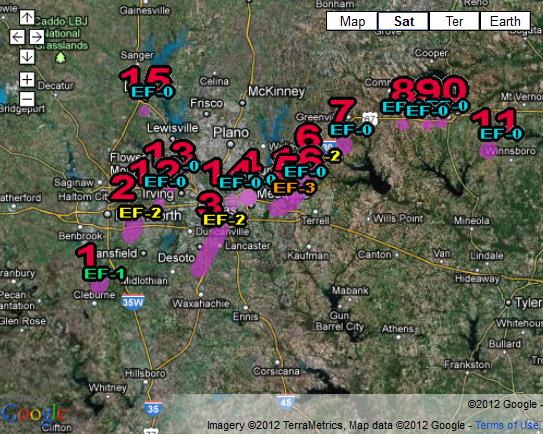
Tornado number 1 occurred southeast of Joshua, in Johnson county. This tornado produced EF1 damage. The path length was 1.1 miles and the path width was approximately 60 yards wide.
Tornado number 2 occurred in Kennedale and Arlington. This tornado produced EF2 damage. The path length was 4.6 miles, and the path width was approximately 150 yards. This width has been updated from earlier reports.
Tornado number 3 occurred in Lancaster and Dallas. This tornado produced EF2 damage. The path length was 7.1 miles, and the width was approximately 200 yards.
Tornado number 4 occurred in Mesquite. This tornado produced EF0 damage. The path length was 0.3 miles, and the width was approximately 30 yards.
Tornado number 5 occurred near Forney, in Kaufman County. This tornado produced EF3 damage. The path length was 8 miles, and the width was approximately 150 yards.
Tornado number 6 occurred near Royse City, beginning in Rockwall County before moving northeast into Hunt County. This tornado produced EF2 damage The path length was 3.1 miles, and the width was approximately 400 yards.
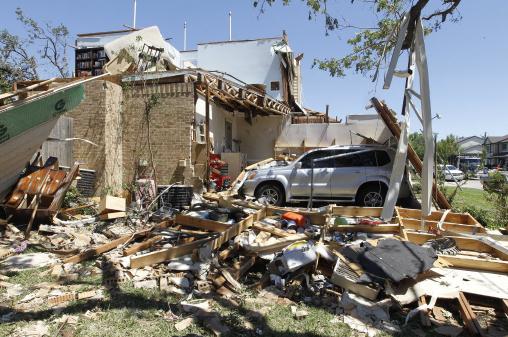
Photo credit above: "A home totally destroyed by the tornado on Haverford Dr. in west Arlington, Texas on Thursday Apr. 5, 2012. (AP Photo/Fort Worth Star-Telegram, Ron T. Ennis)."

Graphic credit above: "The 3-D profile reveals heavy precipitation."

DFW Has Had Surprising Few Tornado Deaths. Chalk it up to good fortune - but at some point I fear our good luck will run out. We're talking pure statistics and probabilities - large (drier/warmer) cities may inhibit the smallest tornadoes from forming, but a big EF-3+ tornado is like the proverbial bear in the woods: it goes where it wants to go, and a few high-rise buildings or skyscrapers won't make a bit of difference. More details from the Fort Worth Star-Telegram: "Twenty-seven people died in 15 minutes on the afternoon of May 27, 1997, in Jarrell, a barely noticeable town 10 miles north of Georgetown. By comparison, 17 people have died in 175 recorded tornadoes in all of Tarrant and Dallas counties in the last 60 years. Sixty years. The tornadoes that touched down near Joshua and in Kennedale, Arlington, Lancaster, Royse City and Forney during a dynamic and anxious Tuesday afternoon in North Texas damaged tens of millions of dollars in property. But no one died, again proving that the region is uncommonly fortunate. "I'm amazed there were no fatalities, given what we saw in the videos," said Chris Weiss, professor of atmospheric science at Texas Tech University and a tornado researcher."

Deadly Storms Strike Bangladesh. Here's a post from AP and Chad Merrill at Earth Networks: "New reports say storms with heavy rains and strong winds have killed at least 17 people and injured dozens more in Bangladesh. Dhaka's Prothom Alo and Janakantha newspapers say Friday's storms damaged mud and straw huts and felled trees in 10 of the country's 64 districts. The reports say most of the deaths occurred from lightning. Some victims were buried under their collapsed houses. Offical confirmation of the reports was not immediately available. Rainstorms are common in Bangladesh, a tropical delta nation of 160 million people."
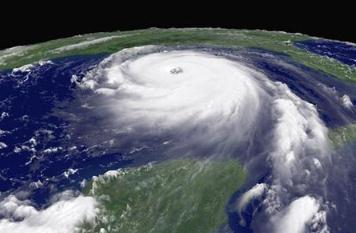
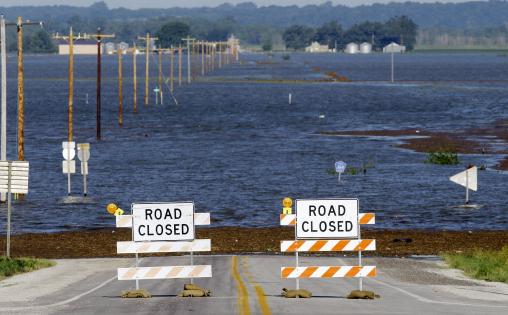
Photo credit above: "Flood waters from the nearby Missouri River cover a county highway, Wednesday, June 15, 2011, in Hamburg, Iowa. The water level continues to rise and officials say that it should crest sometime later this week. (AP Photo/Charlie Neibergall)."
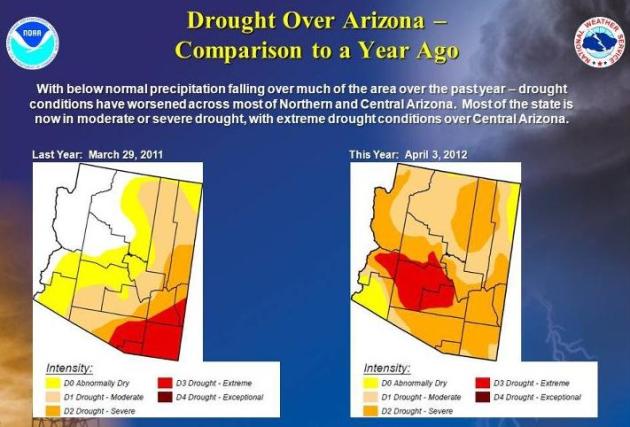

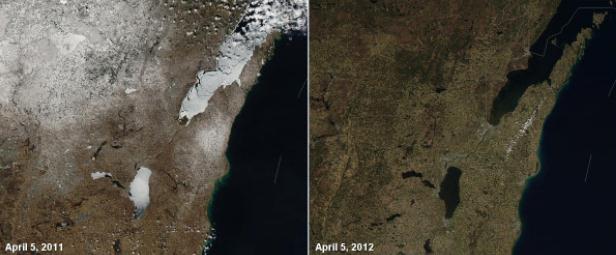



Mystery Photo Of The Day: "Hole Punch Cloud"? Birmingham TV meteorologist James Spann tweated this pic along - and I can't, for the life of me, figure out how this happened. At first I thought "sky-writing", those planes that can trace text and figures into the sky by releasing chemicals? Someone else speculated "downburst", but I don't see any severe T-storms nearby that could have done this. The pic was taken in the Dallas area, hit hard by tornadoes last Tuesday. Any ideas? Odd.
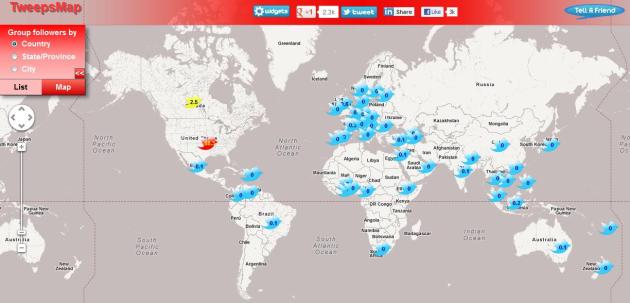
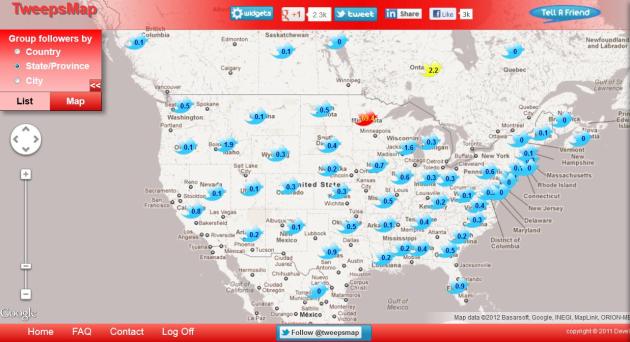
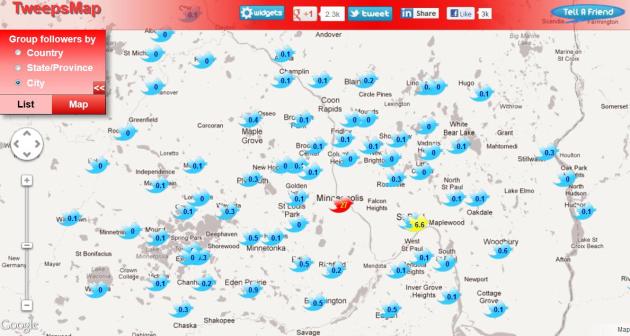
Where Are Your Tweeps? No, not "peeps", "tweeps" (the people who follow you on Twitter). This proves privacy is a thing of the past - now you can see, on a map of the world, USA or county-level, who is following you on Twitter. For example, 27% of my tweeps are in Minneapolis, 6.6% live in the St. Paul area. Ugh. Feeling insecure about my St. Paul cred. More from tweepsmap.com: "88% of my followers are from USA, 69% from Minnesota and 27% from Minneapolis."

Lunch With Meteorologist Paul Douglas. O.K. I'm starting to feel overexposed, but I'm grateful to Jeffrey Morris, "FutureDude", an amazing graphic artist and futurist who has created a remarkable web site (futuredude.com) that's definitely worth a look. I sat down with Jeff a few weeks ago to talk about my career and fascination with weather and technology. Here's an excerpt: "My quest for weather knowledge has never ceased. When I saw my local TV weather man, Paul Douglas, reveal his 3D weather visualization system, EarthWatch, back in 1991 — I was blown away. Here was a three-dimensional visualization of the weather. It was the stuff of science fiction and it was being used in a real and practical way! It was only the beginning. I’ve been a big fan of Paul’s work, and followed the evolution of his products and services with great interest. I also was aware of his involvement as an advisor and provider of graphics for the films Jurassic Park and Twister. Paul Douglas currently owns and operates five weather-related businesses, including the spectacular WeatherNation. I recently had the chance to have lunch with him, where we discussed his interest in weather and the the future of forecasting."

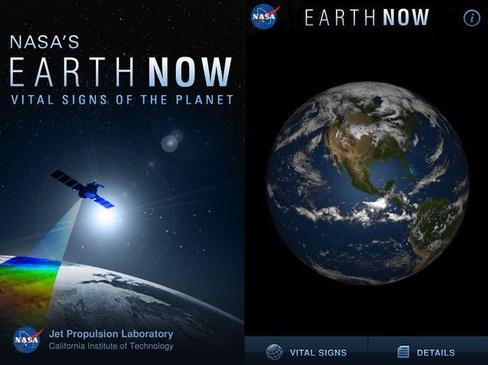

Q: How does a new product come about at Apple?
A: What I love about the creative process, and this may sound naive, but it is this idea that one day there is no idea, and no solution, but then the next day there is an idea. I find that incredibly exciting and conceptually actually remarkable.
The nature of having ideas and creativity is incredibly inspiring. There is an idea which is solitary, fragile and tentative and doesn’t have form.
What we’ve found here is that it then becomes a conversation, although remains very fragile.
When you see the most dramatic shift is when you transition from an abstract idea to a slightly more material conversation. But when you made a 3D model, however crude, you bring form to a nebulous idea, and everything changes - the entire process shifts. It galvanises and brings focus from a broad group of people. It’s a remarkable process.




More Than A "Passing Shower". We had a shower in the forecast, but yesterday's precipitation qualified as "rain", meaning a few hours of steady precipitation. The timing was unfortunate, but it's just what your lawn and emerging flowers needed, and Easter Sunday will be a little greener as a result. The front picked up moisture as it pushed east, dropping only a trace of rain at Alexandria, .03" St. Cloud and .17" in the Twin Cities. Highs ranged from a chilly 49 at Grand Marais to 57 Twin Cities, 58 at St. Cloud (where the sun came out 90 minutes earlier).

Sunrise Panorama. Broadcast Weather meteorologist Todd Nelson snapped this photo - actually a series of 3 pics that was stitched together into 1 sweeping view, using a free iPhone app called
EASTER SUNDAY: Very nice Easter/Passover with a mix of clouds and sun, a stiff breeze. Winds: W 15-25. High: 61
SUNDAY NIGHT: Clearing, turning windy and noticeably colder. Low: 38
MONDAY: Jacket weather. Sunny and brisk. High: 47
TUESDAY: Frosty start for the suburbs. Bright sun, chilly. Low: 33. High: 46
WEDNESDAY: More widespread frost? Light winds under a blue sky. Low: 31. High: 51
THURSDAY: Clouds roll in. PM showers possible. Low: 41. High: 57
FRIDAY: Million-dollar-rain likely, possibly moderate to heavy. Low: 45. High: 54
SATURDAY: Damp start. Some PM sun. Winds: S 10-15. Low: 47. High: 62
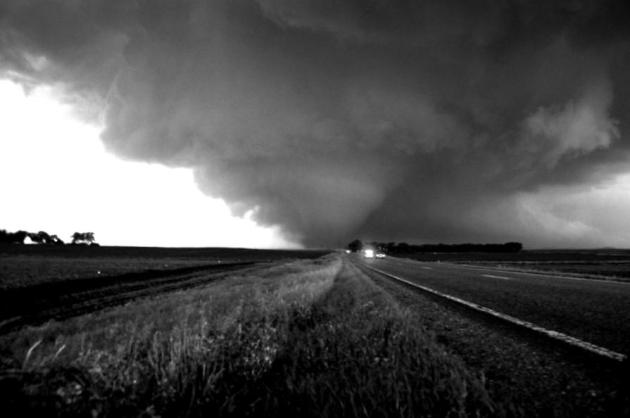
Tornado warnings 2.0
Mea culpa. I had a "passing shower" in the Saturday outlook. Yep, that shower passed overhead (repeatedly) much of the day. Ugh. If I could just time the rain for weekdays, preferably at night. I'm working on that.
This is my favorite time of the year: an almost alien, neon-green landscape. We're in a drought, so I won't gripe about rain, even on a Saturday. Easter Sunday should be drier and milder; the last day of 60s all week.
Dig out a jacket; the best chance of suburban frost comes Tuesday and Wednesday.We may be sliding into a wetter pattern: more rain Thursday and Friday; drier by Saturday PM. In general a southward shift to the jet stream, coupled with a northward penetration of Gulf moisture, may spin up a couple of (badly needed) rain storms in the coming weeks - I'm feeling a little more optimistic for farmers, gardeners, and anyone with a boat.
Is it time to go beyond traditional tornado warnings? The NWS issues them for rotating T-storms, but fewer than 3 in 10 spinning "supercells" will ever spin up a tornado. The result? Apathy. Cynicism "They're crying wolf again Erma!"
But what if a "Tornado Alert" was issued for rotation-based storms. Stay alert, this MAY drop a tornado. If dual-polarizaton Doppler, SKYWARN or police confirm a tornado, the NWS upgrades to "Tornado Emergency". Use strong language; THIS IS REAL FOLKS! Tornado on the ground, take cover now! A humble proposition from a very paranoid weatherman.
* photo above of the June 17, 2010 tornado near Albert Lea courtesy of Broadcast Weather meteorologist Aaron Shaffer.
Climate Stories....

1981 Climate Predictions Were Eerily Accurate. Here's an excerpt of a story from io9.com: "A paper published in the journal Science in August 1981 made several projections regarding future climate change and anthropogenic global warming based on manmade CO2 emissions. As it turns out, the authors' projections have proven to be rather accurate - and their future is now our present. The paper, written by a team of atmospheric physicists led by the now-controversial James Hansen at NASA's Institute for Space Studies at Goddard Space Flight Center, was recently rediscovered by researchers Geert Jan van Oldenborgh and Rein Haarsma from the Royal Netherlands Meteorological Institute (KNMI). Taking a break from research due to illness, the scientists got a chance to look back through some older, overlooked publications."
Photo credit above: "The retreat of Pedersen Glacier in Alaska. Left: summer 1917. Right: summer 2005. Source: The Glacier Photograph Collection, National Snow and Ice Data Center/World Data Center for Glaciology."

Five Myths About Water. Here's an excerpt of a fascinating read from The Washington Post: "Water is the most familiar substance in our lives, and the most important. Every cell in our bodies is plumped full of water; every heartbeat, every thought — including thoughts about water — happens only because of the cascade of chemistry that water makes possible. Yet we know almost nothing about water, starting with such basics as: Where does our water come from? Where does it go once it disappears down the drain? In fact, even what we think we know about water is often wrong.
We see it in the headlines almost every day: Drought in Texas and China. Nevada’s Lake Mead in danger of going dry. The Colorado River and the Rio Grande no longer flowing to the sea."
Warming: Scientific Fact. Here's an Op-Ed in the Charleston Gazette, in the heart of West Virginia coal country. I admire their courage in stepping up and acknowledging the scientific facts. Here's an excerpt of an Op-Ed you should read: ....The internal documents also allege that the Koch brothers, conservative oil billionaires, gave Heartland $200,000. New Jersey's Star-Ledger pointed out that the Kochs "backed climate-denier Newt Gingrich's presidential campaign," and their donation shows that Heartland "is a shill for oil companies that have a huge profit motive in dirty fossil fuels." The paper continued: "Climate change deniers use a strategy identical to those who want creationism taught alongside evolution in science classes: Ignore the science and teach the debate, as if the simple fact of disagreeing with scientific fact is educationally significant ... . It's deliberate ignorance. That's the same pseudoscience that leads parents to opt out of vaccinations for their children or oppose fluoride in drinking water. The stakes in climate change are much higher -- planetary, in fact."

"TRENBERTH: Spring has been moving up. It has been generally the case, but - this year especially so. And the tornado season seems to have moved up as well.
CONAN: And that means there are going to be more of these storms, no?
TRENBERTH: Well, you know, tornadoes vary quite a lot from year to year, and they depend on other factors, as to whether the jet stream is in just the right location and certainly the warm moist air coming out of the Gulf. And, you know, that's part of the climate change aspect, is that the air coming out of the Gulf is a bit warmer and moister. And so it helps to invigorate the thunderstorms that host these tornadoes. So that is one factor that's underplayed, but there is a lot of variability, of course, from year to year."
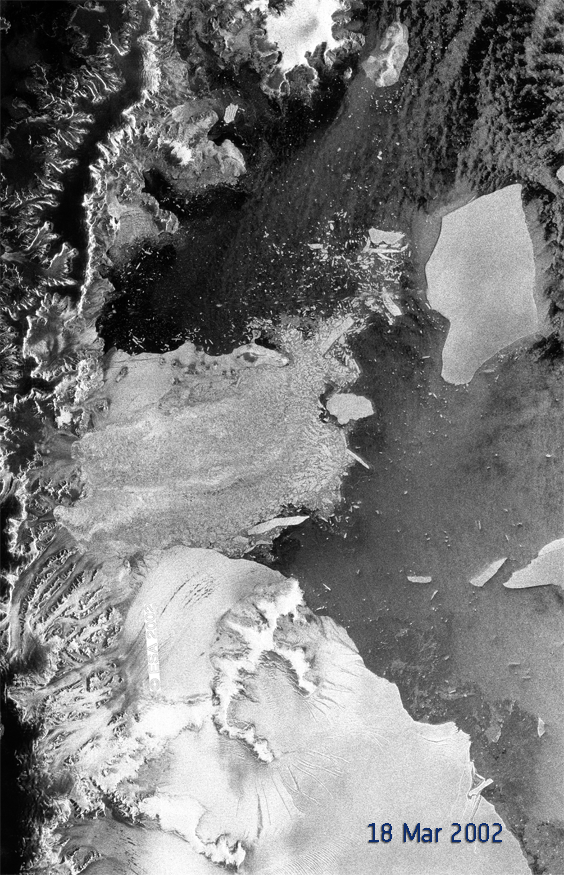
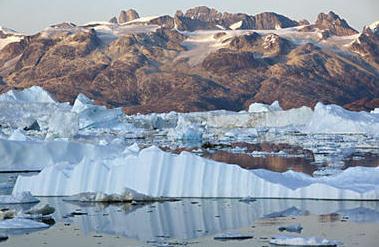
Ecosystems Dependent On Snow And Ice "Most Threatened" By Global Warming. Details from newstrackindia.com: "Washington, April 7 (ANI): With increasing global warming, the most threatened ecosystems are those that depend on a season of snow and ice, scientists say. The finding results from more than 30 years of Long Term Ecological Research (LTER), a program of the National Science Foundation (NSF). "The vulnerability of cool, wet areas to climate change is striking," said Julia Jones, a lead author of the study. In semi-arid regions like the southwestern United States, mountain snowpacks are the dominant source of water for human consumption and irrigation. Research by Jones and her colleagues showed that as average temperatures increase in these snowy ecosystems, a significant amount of stream water is lost to the atmosphere." Photo: Reuters.

Photo credit above: "Changed patterns of deep sea circulation resulted in less sea ice around Antarctica at the end of the last ice age, part of a broader process that led to an influx of carbon dioxide in the atmosphere. This photo shows Antarctic sea ice today. Alister Doyle/REUTERS/File."

Photo credit above: "Prof Jim Hansen: 'We’re handing future generations a climate system which is potentially out of their control'. Photograph: Melanie Patterson/AP."

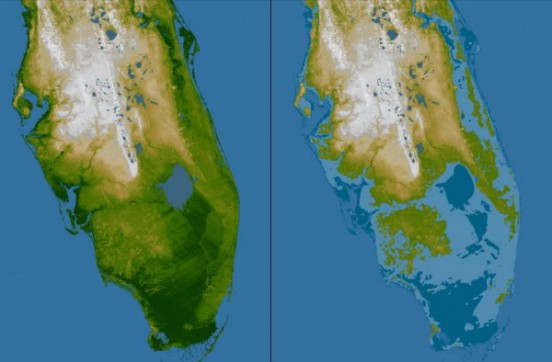



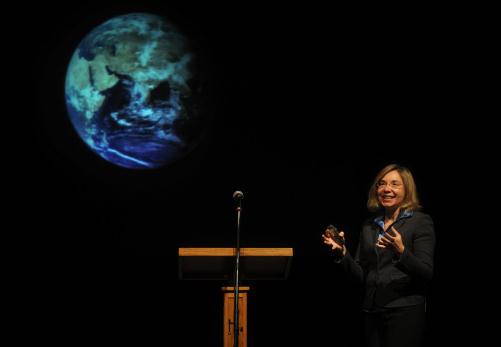
Photo credit above: "Climate scientist Katharine Hayhoe delivers her Faith Based Response to Climate Change talk to students and faculty during chapel at Hardin-Simmons University Tuesday, April 3, 2012, in Abilene, Texas. (AP Photo, Abilene Reporter-News/Nellie Doneva)."

Video credit above: "Spring" in Moscow (RIA Novosti / Vladimir Astapkovich).

Photo credit above: Scott Gries/PictureGroup.


Photo credit above: "US President Barack Obama delivers remarks urging Congress to vote on the 'Repeal Big Oil Tax Subsidies Act', as supporters look on, in the Rose Garden of the White House in Washington D.C. (Michael Reynolds / EPA / March 29, 2012)."
No comments:
Post a Comment